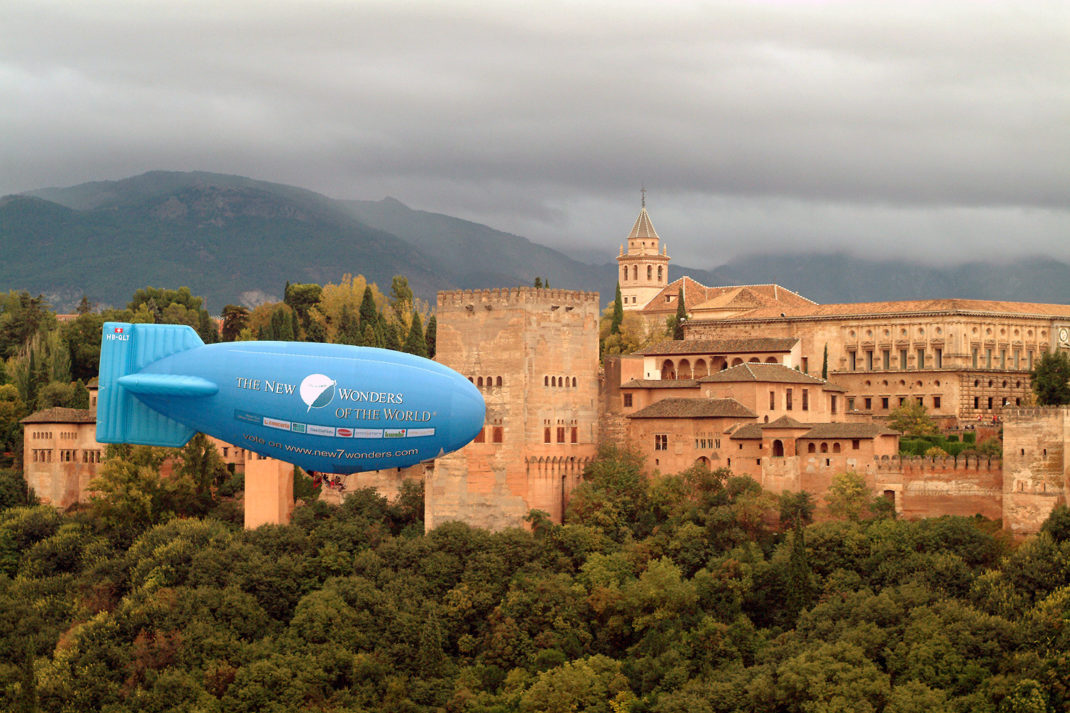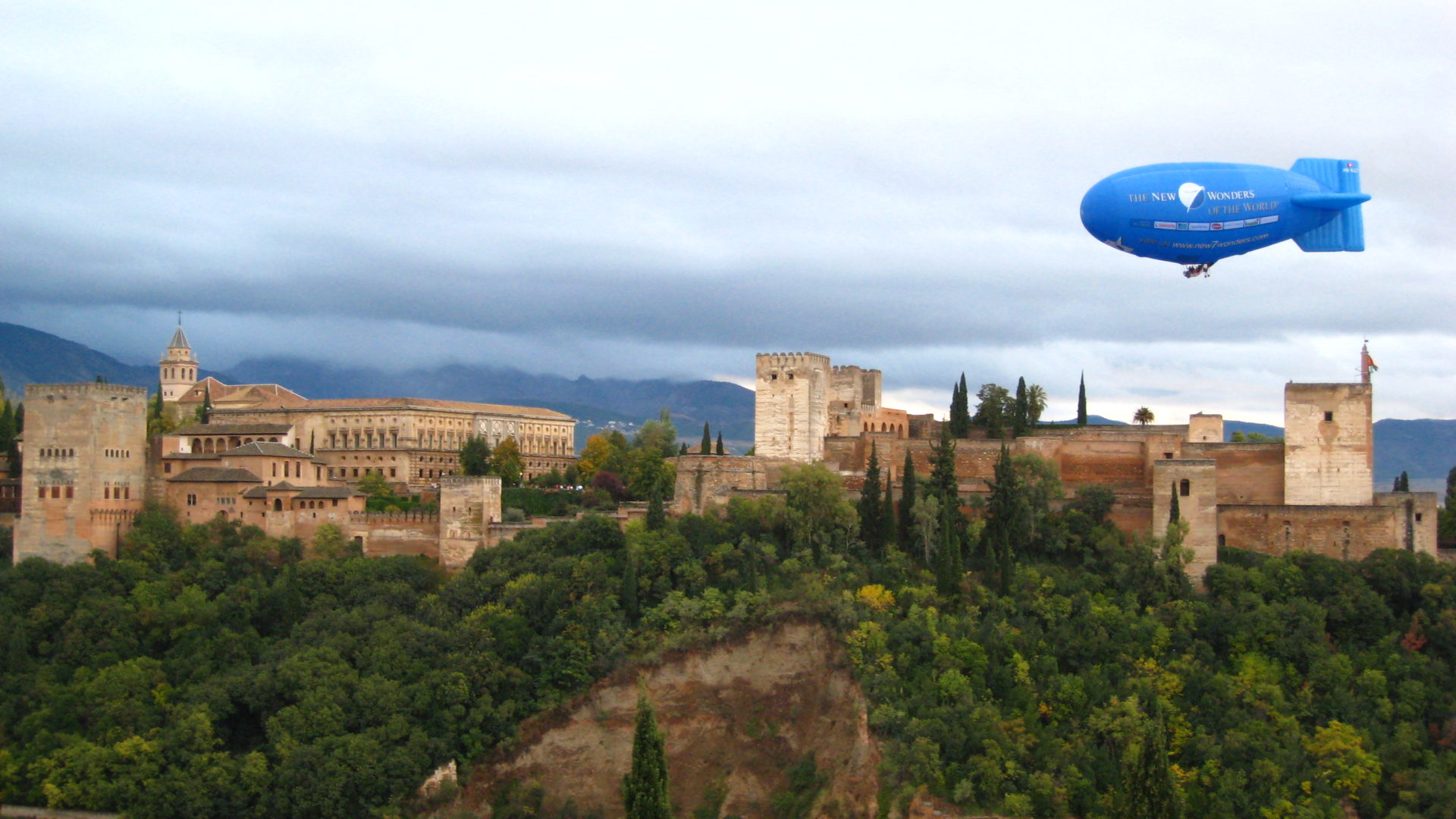One of the 21 Finalists
Alhambra
Granada, Spain
The Alhambra (/ælˈhæmbrə/; Spanish: [aˈlambɾa]; Arabic: الْحَمْرَاء [ʔælħæmˈɾˠɑːʔ], Al-Ḥamrā, lit. “The Red One”), the complete Arabic form of which was Qalat Al-Hamra, is a palace and fortress complex located in Granada, Andalusia, Spain. It was originally constructed as a small fortress in AD 889 on the remains of Roman fortifications and then largely ignored until its ruins were renovated and rebuilt in the mid-13th century by the Moorish emir Mohammed ben Al-Ahmar of the Emirate of Granada, who built its current palace and walls. It was converted into a royal palace in 1333 by Yusuf I, Sultan of Granada. After the conclusion of the Christian Reconquista in 1492, the site became the Royal Court of Ferdinand and Isabella (where Christopher Columbus received royal endorsement for his expedition) and the palaces were partially altered to Renaissance tastes. In 1526 Charles I & V commissioned a new Renaissance palace better befitting of the Holy Roman Emperor in the revolutionary Mannerist style influenced by Humanist philosophy in direct juxtaposition with the Nasrid Andalusian architecture, but which was ultimately never completed due to Morisco rebellions in Granada.
Alhambra’s late flowering of Islamic palaces were built for the last Muslim emirs in Spain during the decline of the Nasrid dynasty who were increasingly subject to the Christian Kings of Castile. After being allowed to fall into disrepair for centuries, the buildings occupied by squatters, Alhambra was rediscovered following the defeat of Napoleon, who had conducted retaliatory destruction of the site, the re-discoverers were first British intellectuals and then other north European Romantic travelers. It is now one of Spain’s major tourist attractions, exhibiting the country’s most significant and well-known Islamic architecture, together with 16th-century and later Christian building and garden interventions. The Alhambra is a UNESCO World Heritage Site and the inspiration for many songs and stories.
Moorish poets described it as “a pearl set in emeralds,” an allusion to the colour of its buildings and the woods around them. The palace complex was designed with the mountainous site in mind and many forms of technology were considered. The park (Alameda de la Alhambra), which is overgrown with wildflowers and grass in the spring, was planted by the Moors with roses, oranges, and myrtles; its most characteristic feature, however, is the dense wood of English elms brought by the Duke of Wellington in 1812. The park has a multitude of nightingales and is usually filled with the sound of running water from several fountains and cascades. These are supplied through a conduit 8 km (5.0 mi) long, which is connected with the Darro at the monastery of Jesus del Valle above Granada.
Despite long neglect, willful vandalism, and some ill-judged restoration, the Alhambra endures as an atypical example of Muslim art in its final European stages, relatively uninfluenced by the direct Byzantine influences found in the Mezquita of Córdoba. The majority of the palace buildings are quadrangular in plan, with all the rooms opening on to a central court, and the whole reached its present size simply by the gradual addition of new quadrangles, designed on the same principle, though varying in dimensions, and connected with each other by smaller rooms and passages. Alhambra was extended by the different Muslim rulers who lived in the complex. However, each new section that was added followed the consistent theme of “paradise on earth”. Column arcades, fountains with running water, and reflecting pools were used to add to the aesthetic and functional complexity. In every case, the exterior was left plain and austere. Sun and wind were freely admitted. Blue, red, and a golden yellow, all somewhat faded through lapse of time and exposure, are the colors chiefly employed.
The decoration consists for the upper part of the walls, as a rule, of Arabic inscriptions -mostly poems by Ibn Zamrak and others praising the palace- that are manipulated into geometrical patterns with vegetal background set onto an arabesque setting (“Ataurique”). Much of this ornament is carved stucco (plaster) rather than stone. Tile mosaics (“alicatado”), with complicated mathematical patterns (“tracería”, most precisely “lacería”), are largely used as panelling for the lower part. Similar designs are displayed on wooden ceilings (Alfarje). Muqarnas are the main elements for vaulting with stucco, and some of the most accomplished dome examples of this kind are in the Court of the Lions halls. The palace complex is designed in the Nasrid style, the last blooming of Islamic Art in the Iberian Peninsula, that had a great influence on the Maghreb to the present day, and on contemporary Mudejar Art, which is characteristic of western elements reinterpreted into Islamic forms and widely popular during the Reconquista in Spain.


